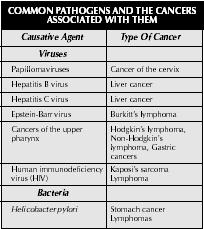Cancer - Causes
The major risk factors for cancer are tobacco and alcohol use, diet, sexual and reproductive behavior, infectious agents, family history, occupation, radiation, and pollution.
The American Cancer Society estimates that about 40 percent of all cancer deaths in the United States are caused by tobacco and excessive alcohol use. An additional one-third of the deaths are caused by poor diet and nutrition. The vast majority of deaths from skin cancer are due to overexposure to ultraviolet light in the sun's rays.
Tobacco
Smoking is responsible for 80 to 90 percent of all cases of lung cancer (see lung cancer entry). Smoking is also a factor in other forms of cancer affecting the upper respiratory (breathing) tract, larynx, bladder, pancreas, and, probably, liver, stomach, and kidney. Secondhand smoke (smoke exhaled by smokers and inhaled by others nearby) can also increase the risk of developing cancer.
Alcohol
People who drink too much alcohol are at risk for certain forms of cancer, such as liver cancer. In combination with smoking, the use of alcohol can also increase the risk of developing cancer of the mouth, pharynx (pronounced FAHR-inks), larynx, and esophagus (pronounced SAH-fuh-guss).
Diet
One in three cancers can be traced to dietary factors. Obesity (see obesity entry) has been connected with cancers of the breast, colon, rectum, pancreas, prostate, gallbladder, ovaries, and uterus.
Sexual and Reproductive Behaviors
Some cancer-causing viruses can be transmitted by sexual activity. People who begin sexual activity early in their lives and have many partners appear to have a higher risk for developing cancer. Women who never have children or have them late in life may be at higher risk for developing ovarian and breast cancer.
Infectious Agents
Scientists believe that about 15 percent of all cancers are caused by viruses, bacteria, or parasites. A list of the most common cancer-causing infectious agents is shown in the table below.
Family History
Certain forms of cancer recur generation after generation in some families. These include breast, colon, ovarian, and uterine cancers.

| COMMON PATHOGENS AND THE CANCERS ASSOCIATED WITH THEM | |
| Causative Agent | Type Of Cancer |
| Viruses | |
| Papillomaviruses | Cancer of the cervix |
| Hepatitis B virus | Liver cancer |
| Hepatitis C virus | Liver cancer |
| Epstein-Barr virus | Burkitt's lymphoma |
| Cancers of the upper pharynx | Hodgkin's lymphoma, Non-Hodgkin's lymphoma, Gastric cancers |
| Human immunodeficiency virus (HIV) | Kaposi's sarcoma Lymphoma |
| Bacteria | |
| Helicobacter pylori | Stomach cancer Lymphomas |
Occupational Hazards
About 4 percent of all cancers are thought to be connected with one's occupation. For example, people who work with asbestos have an increased chance of developing lung cancer. Asbestos is a naturally occurring mineral that was once used widely as insulation for housing and other buildings. Many other forms of occupational cancer have been identified. These include:
- Bladder cancer, among dye, rubber, and gas workers
- Skin and lung cancer, among those who work in smelters, with arsenic, and in gold mines
- Leukemia, among glue and varnish workers
- Liver cancer, among workers in the PVC (polyvinyl chloride plastics) industry
- Lung, bone, and bone marrow cancer, among people who work with X rays and other forms of radiation, or with uranium
Radiation
Ultraviolet radiation is responsible for the majority of deaths from melanoma. Other sources of radiation include X rays, radon gas, and radiation from nuclear materials. These sources combined are thought to be responsible for about 1 to 2 percent of all cancer deaths.
Pollution
Experts think that roughly 1 percent of all cancer deaths are caused by air, land, and water pollution. Industries that release harmful chemicals into the environment are the primary source of these pollutants.

Comment about this article, ask questions, or add new information about this topic: